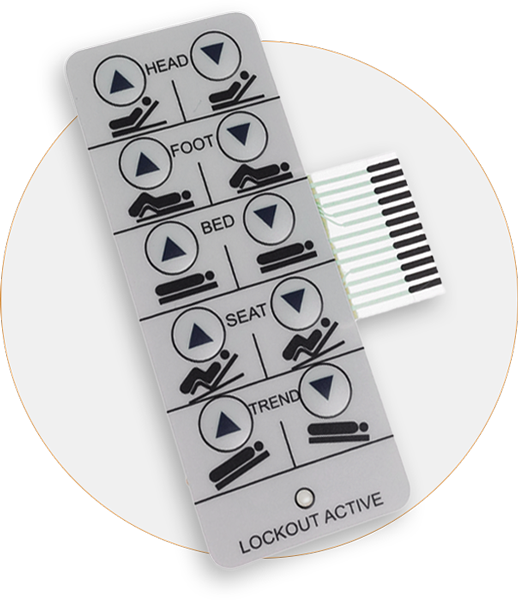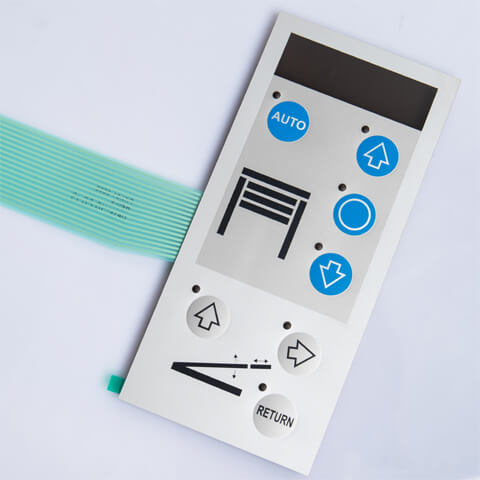Recognizing the Capability of Membrane Switches Over for Interface Devices
The functionality of membrane layer changes represents a significant development in individual interface layout, incorporating efficiency with visual convenience. As markets increasingly focus on individual experience, understanding the nuances of membrane layer switch technology comes to be important.
What Are Membrane Layer Switches?
Membrane switches are innovative user interface tools that promote user interaction with electronic devices. These flexible components include multiple layers, consisting of a visuals overlay, spacer, and a published circuit layer. The layout enables a smooth assimilation right into various digital gadgets, enhancing both the aesthetic and practical elements of customer interfaces.
Membrane switches are frequently utilized in a vast array of applications, from household appliances to commercial machinery and medical tools. Their building and construction usually features a thin profile, making them an ideal option for compact styles. The responsive comments supplied by these buttons can be crafted to fulfill specific customer choices, guaranteeing efficient communication between the user and the tool.
Resilience is one more significant advantage of membrane layer buttons, as they are resistant to dust, dampness, and chemicals, which improves their lifespan sought after environments. Additionally, these buttons can be tailored in regards to form, dimension, and graphic layout, enabling branding and user-specific attributes. In general, membrane switches represent a practical remedy for boosting user experience in electronic gadgets, combining performance with aesthetic allure in an effective fashion.
Exactly How Membrane Switches Over Job
Operating on a straightforward principle, membrane switches make use of a split building to sign up individual input effectively. Each switch includes numerous layers, consisting of a published circuit layer, a spacer layer, and a top visuals layer, which are made to collaborate perfectly. When a customer presses the top layer, it presses the spacer layer, bringing the conductive aspects of the circuit layer right into contact with each other.
This contact produces a closed circuit, signifying the gadget to perform a details feature. The design enables numerous configurations, including responsive feedback, which can enhance the user experience by giving a physical feeling upon activation. The materials utilized in membrane layer switches usually consist of versatile substratums, such as polyester or polycarbonate, which ensure longevity and strength against damage.

Trick Benefits of Membrane Switches

Another significant benefit is their density. Membrane buttons are slim and light-weight, which enables suppliers to save area in their tools without giving up performance. This feature is particularly valuable in applications where weight and quantity are crucial factors to consider.
In addition, membrane layer buttons are resistant to dirt, moisture, and chemicals, improving their resilience. This durability expands their lifespan and minimizes the demand for frequent substitutes, leading to price savings over time.
Furthermore, the responsive responses provided by membrane layer switches can be optimized to enhance customer communication. They can include attributes such as increased switches or distinct clicks, boosting use and customer experience.
Applications Throughout Industries
Interface gadgets utilizing membrane layer buttons prevail in a broad variety of industries, showcasing their flexibility and performance. Membrane Switch. In the medical market, membrane buttons are integral to gadgets such as diagnostic devices and individual monitoring systems, where their resilience and convenience of cleansing are important for preserving health requirements. Likewise, in the auto industry, these switches are used in control panel controls and infotainment systems, providing a streamlined and modern-day user interface for users.
Moreover, the consumer electronic devices industry advantages from membrane switches my response in appliances and portable gadgets, where compact layout and easy to use user interfaces enhance user experience. Industrial applications likewise take advantage of membrane layer changes for control panels in machinery and automation systems, emphasizing their effectiveness and resistance to severe settings.
In the aerospace and protection industries, membrane buttons are used in cabin controls and tools, where reliability and performance under severe problems are extremely important. Additionally, the video gaming market significantly includes membrane layer buttons in controllers and gallery makers, adding to an interesting customer experience. In general, the flexibility of membrane changes enables their prevalent use across various sectors, emphasizing their significance in modern-day user interface style.
Future Fads in Membrane Switch Modern Technology

In addition, making use of innovative products, such as polycarbonate and polyester movies, is anticipated to rise, offering improved toughness and resistance to ecological stress factors. These materials add to the general durability of membrane layer switches, making them appropriate for harsher commercial applications.
Additionally, the unification of clever modern technology, consisting of IoT connectivity, will certainly make it possible for membrane switches to interact with various other devices and systems, helping with a more interactive customer experience. This fad straightens with the growing need for smart gadgets across different markets, from medical care to customer electronics.
Finally, customization alternatives are expected to increase, allowing manufacturers to develop bespoke remedies tailored to details individual needs and preferences. These growths will place membrane layer buttons as necessary elements in the evolution of user interface modern technology.
Verdict
In conclusion, membrane switches over stand for a crucial improvement in my latest blog post user interface innovation, providing a reputable and versatile remedy for varied digital applications. As innovations in material science and touch picking up innovations continue, the performance and applicability of membrane buttons are expected to increase, reinforcing their value in modern-day electronic gadgets.